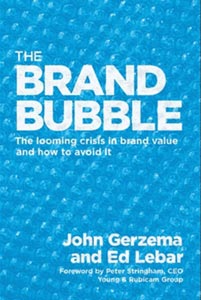
By The Independent Team
This is a new self-help book for brand strategists, marketers, and corporate managers whose salient point is one: A brand is only valuable as long as it’s moving forward. Just as a shark must keep swimming to stay alive, brands must keep moving forward to maintain their energy and strength.
According to several reviewers, the main benefit for the readers is that they become more effective in assessing what their brand is actually worth ‘” and how to boost that value.
One such review was by Bob Gilbreath, who is Bridge Worldwide’s Chief Marketing Strategist. He had six years as a Brand Manager at Procter & Gamble.
Gilbreath notes that based on historic 15-year long BrandAsset Valuator information, which tracks consumer opinion on thousands of brands, the authors found that nearly every major brand has seen declining equity value in recent years. They pair this with data that suggests people are much less brand loyal and are more indifferent to advertising than ever before. But what’s even scarier is that the valuations of brands in stock price have steadily increased (even allowing for the recent nosedive in stocks). Hence, the ‘brand bubble’ is the next to pop.
The key factor that winners share is energy; in the brand sense, energy is ‘the consumer perception of motion and direction in a brand.’ These brands create a constant sense of interest and excitement. Consumers sense they move faster, see farther, and are highly experiential and more responsive to their future needs. The more energy a brand has, the greater the consideration, loyalty, elasticity, pricing power, and brand value (as a percentage of firm value) it commands.
This unique measure establishes a direct link between brand momentum and creativity, financial earnings, and stock performance. Using the BrandAsset Valuator as a guide, the authors walk the reader through examples of these high-energy brands (such as Lego, IKEA, Virgin, and Whole Foods) and share the keys to success in bringing momentum to your brand.
Gilbreath says he was happy to see clear consistency with the direction of Marketing with Meaning. This book does a lot to promote the idea of ‘purpose brands’: Decide what higher-level goal or reason for existence your brand has, and then choose marketing accordingly. Once your brand has dedicated itself to a purpose, the next step is to create meaningful marketing that delivers on that purpose.
A review by John Farquhar focuses on the loss of Brand Asset Value (BAV) when brands lose their energy and consumers drift away and form new alliances. He is excited by the authors claim that they can predict when brands move into the danger zone and offer a remedial solution. But he cautions that the book is based on the American market, which is unique, competitive and highly cut-throat.
The decline in BAV is due to the competitive nature of business, where the scramble for more turnover leads to an ever-growing stream of brands, more fragmentation of categories, a lack of distinctive creativity, and a departure from the basic rule of brand marketing: Namely, distilling brand value to a single promise with a clear benefit and keeping it relevant over time.
In addition, there is a need to re-examine the distribution logistics. Over the past two decades there has been a huge shift in power from the marketer to the retailer. To illustrate the degree of brand proliferation, the authors draw attention to Unilever’s culling of 400 brands in 2008. They argue that creativity in advertising alone will not do the trick – there is currently far too much advertising overkill and marketers have done little to build trust. The result, consumer trust in brands has declined by 50% in a decade, down from 52% to 25%.
Marketers also have to take cognisance of the fact that different generations have an effect on brand perception. This is an ongoing cycle as each generation influences taste. There is, however, only one measure for a product and brand: ‘Does it deliver against expectation?’ It appears that as advertising loses its efficacy, word-of-mouth prevails. Because brand value has a persona of its own, it can have a positive or negative effect on sales depending upon where it comes from.
The iPod, iPhone and Blackberry owe their success to the creative genius behind each. The task of marketing is to maintain that energy through product development, advertising, promotion etc.
With brands, consumers look for a return: Enjoyment, knowledge, security, appearance, social stature, satisfaction. That’s why brands must stay ‘conceptually’ new. Marketers can’t hunt for consumers. Consumers hunt for brands. They know what they want through social intercourse. ‘What if’ doesn’t work anymore because innovation moves in leaps and bounds. The internet has exposed people to ‘what is’ and their inventiveness has found new expression.
How does the Virgin brand stay energised? Sir Richard Branson is the catalyst: Public relations is an under-used tool – and he uses it magnificently.
 The Independent Uganda: You get the Truth we Pay the Price
The Independent Uganda: You get the Truth we Pay the Price



